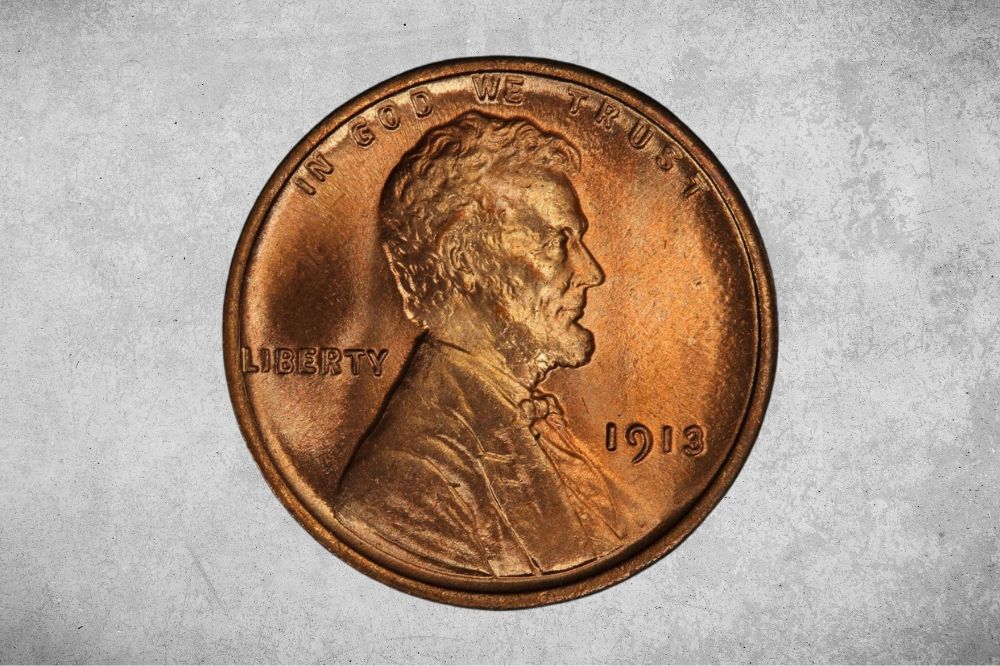It’s been more than a hundred years since the US mint put the 1913 Lincoln Wheat penny into circulation. Did you manage to get your hands on this coin? Do you have plans to buy it?
Whatever the case, you are at the right place. We will discuss the 1913 penny value, its history, grading, errors, and more. Continue reading and find out all you need to know about this coin.
1913 Penny Value Details
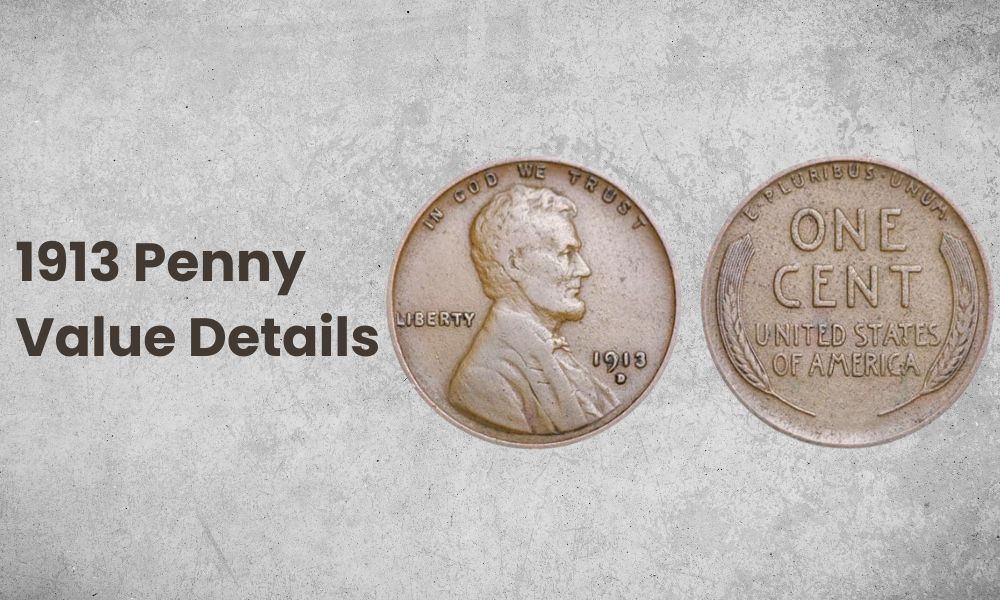
- Category – small cents
- Mint – Philadelphia, Denver, San Francisco
- Mintage – around 96 million total
- Obverse designer – Victor David Brenner
- Reverse designer – Victor David Brenner
- Composition – 95% copper, 5% zinc and tin
- Weight – 3.11 grams (0.10 ounces)
- Diameter – 19.05 millimeters (0.75 inches)
A penny produced in 1913 belongs to the category of small US cents. It is also known as Lincoln cent because the design features the ex-president of the United States, Abraham Lincoln.
The US mint produced almost a hundred million of these coins in 1913. The pennies were produced in three mints – Philadelphia, Denver, and San Francisco.
Most coins were produced in Philadelphia, with around 76 million, followed by Denver with around 13 million, and San Francisco with only around 7 million.
The coins produced in Philadelphia do not have mint marks, while the ones from the Denver mint have a D mint mark, and those from San Francisco are marked with the letter S.
The pennies from 1913 are made of mostly copper and a small amount of tin and zinc. They are just over 3 grams heavy and have a diameter of 19 millimeters.
Also Read: Top 20 Most Valuable Old Pennies Worth Money (Penny Collection)
1913 Penny Value Chart
Since a lot of pennies were minted in 1913, they are not particularly rare or valuable. Those with D and S mint marks are slightly more expensive because of lower mintage.
The 1913 penny can be sold or bought for half a dollar to three dollars if in poor condition.
The prices rise with the quality of the coin, so if yours is in about good, good, or very good condition, you can expect to get $2 to $20.
If you want to sell or buy a 1913 penny in fine, very fine, or about uncirculated condition, you can expect to do so at around $8 to $40.
The coins that are in the mint state can be sold starting at around $50. The prices can reach hundreds, if not thousands of dollars, depending on the exact condition, mint mark, and rarity of the coin.
| Condition | 1913 Penny No Mint Mark Value | 1913 Penny D Mint Mark Value | 1913 Penny S Mint Mark Value |
| Poor | $0.50 – $1 | $1 – $2 | $1 – $3 |
| Fair | $1 – $2 | $2 – $3 | $3 – $5 |
| About Good | $2 – $3 | $3 – $5 | $5 – $7 |
| Good | $3 – $5 | $6 – $10 | $7 – $10 |
| Very Good | $5 – $8 | $10 – $15 | $10 – $15 |
| Fine | $8 – $12 | $15 – $20 | $15 – $20 |
| Very Fine | $12 – $20 | $20 – $25 | $20 – $30 |
| About Uncirculated | $20 – $50 | $25 – $35 | $30 – $45 |
| Mint State (60-64) | $50 – $70 | $40 – $80 | $50 – $90 |
| Mint State (65+) | $70 – $700 + | $80 – $900 + | $90 – $1 000 + |
1913 Penny Value & Varieties Guides
Since the 1913 penny was minted in three different locations, there are three varieties of this timeless coin. However, all three varieties feature the same design.
The obverse of the coin depicts a right-side profile of Abraham Lincoln at the center of the penny.
On the left side of the profile is the word LIBERTY, which replaced the portrait of Lady Liberty previously depicted on the coin.
On President Lincoln’s right side is the year in which the coin was minted, in this case, 1913. Just below the year, you can see a mint mark, indicating where the penny was produced. In the case of the Philadelphia mint, the mint mark is non-existent.
The reverse side is interesting as well. It contains two ears of wheat circling the edges of the coin on the inside. Wheat was supposed to represent the immense importance of agriculture to the economy of the country.
At the center of the coin, you can see the words ONE CENT and just below them UNITED STATES OF AMERICA.
The top of the penny is reserved for the country’s motto, E PLURIBUS UNUM, meaning “Out of many, one”, indicating that the country is composed of many states that act as one, symbolizing unity and solidarity.
1913 Penny No Mint Mark
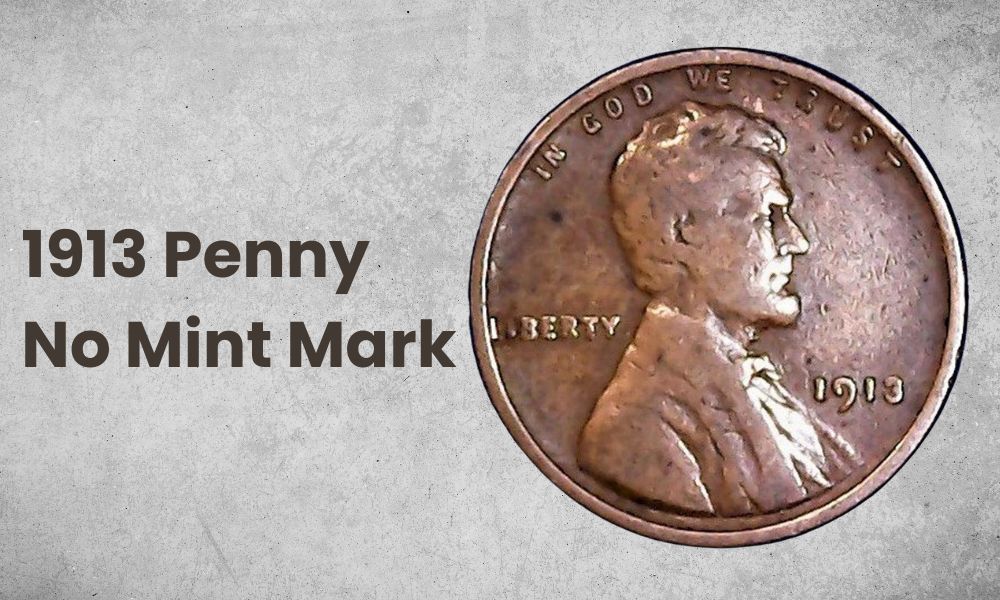
- Type – wheat penny
- Edge – plain
- Mint mark – no mint mark
- Place of minting – Philadelphia
- Year of minting – 1913
- Face value – one cent
- Price – $0.50 – $700 +
- Quantity produced – 76 000 000
- Designer – Victor David Brenner
- Composition – 95% copper and 5% tin and zinc
- Weight – 3.1 grams
- Diameter – 19 millimeters
A penny made in 1913 with no mint mark was produced in the Philadelphia mint. Because this facility hadn’t started using mint marks at the time yet.
This variety is the most common out of the three because Philadelphia minted much more coins than the other two mints. This makes the 1913 penny with no mint mark quite common.
The prices reflect this. If you have a 1913 penny with no mint mark in poor condition, the most you can expect to get is a couple of dollars. If you have one in perfect condition and possibly containing some unique errors you can get hundreds, but the coins in this state are rare.
1913 Penny D Mint Mark
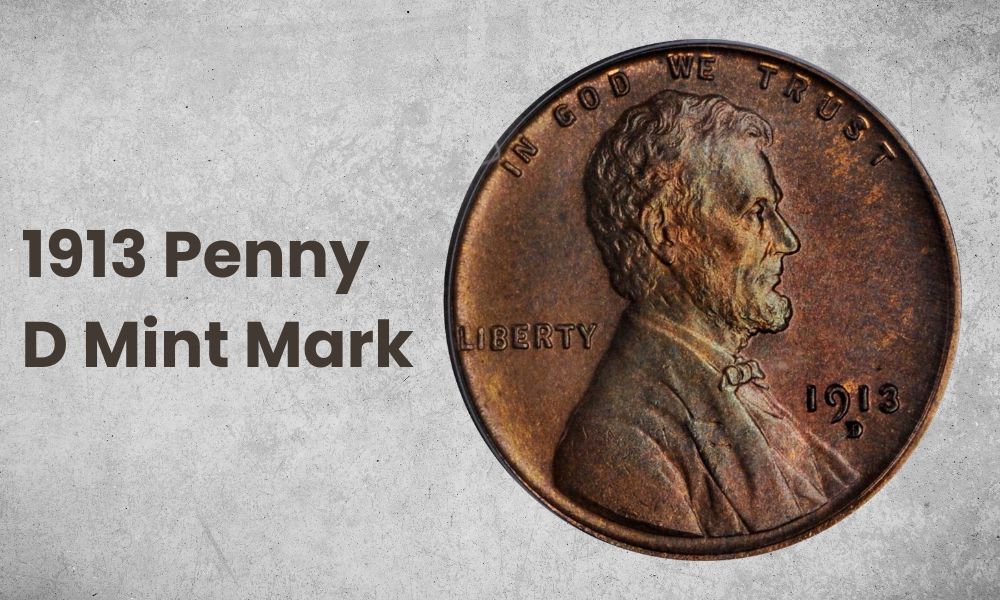
The 1913 penny made in Denver looks exactly the same as its counterpart from Philadelphia. The only difference is the D mint mark that you can find on the obverse of the coin, right next to Lincoln’s portrait, on the right side.
This variety is slightly more expensive though. The coin is worth several dollars in bad condition, but if you have a penny that looks uncirculated you can get up to a hundred dollars.
In case you have a coin that looks brand new, you can expect to get even hundreds if you find the right buyer or auction.
- Type – wheat penny
- Edge – plain
- Mint mark – D
- Place of minting – Denver
- Year of minting – 1913
- Face value – one cent
- Price – $1 – $900 +
- Quantity produced – 13 000 000
- Designer – Victor David Brenner
- Composition – 95% copper and 5% tin and zinc
- Weight – 3.1 grams
- Diameter – 19 millimeters
1913 Penny S Mint Mark
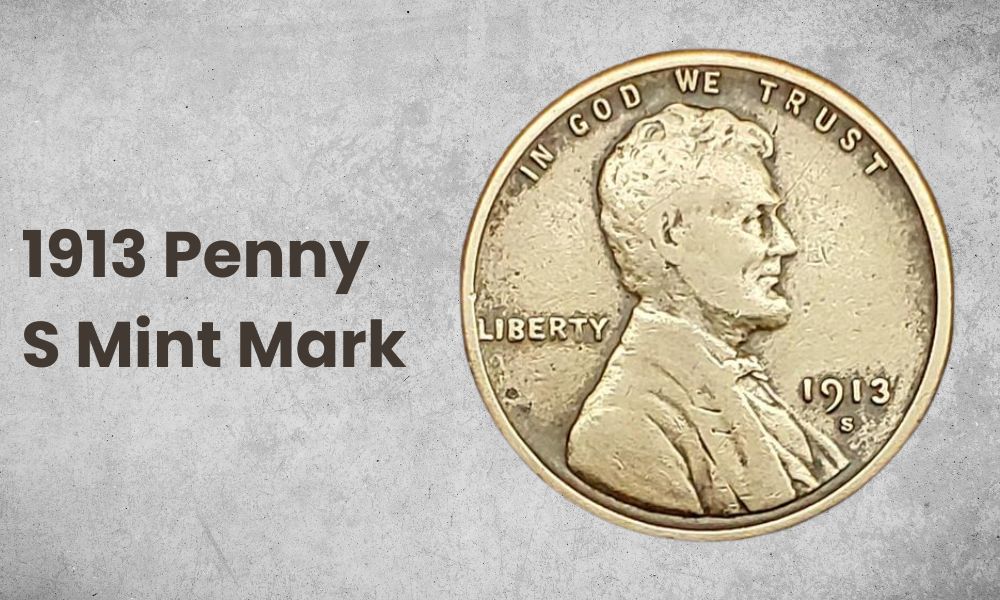
Finally, the penny made in 1913 in San Francisco is the rarest out of the three. Only around 7 million coins were produced in this mint, so they are worth a bit more than the previous two varieties.
The prices aren’t that different from pennies with no and D mint marks if the coin is in poor condition. However, if you have a mint state coin, you can possibly get more than a thousand dollars for it, as those are quite rare.
- Type – wheat penny
- Edge – plain
- Mint mark – S
- Place of minting – San Francisco
- Year of minting – 1913
- Face value – one cent
- Price – $1 – $1 000 +
- Quantity produced – 7 000 000
- Designer – Victor David Brenner
- Composition – 95% copper and 5% tin and zinc
- Weight – 3.1 grams
- Diameter – 19 millimeters
1913 Penny History
Towards the end of the 19th and the beginning of the 20th century, the US used the Indian Head penny, a beautiful coin designed to celebrate the Native American culture. This coin was used for exactly 50 years until the US mint decided it was time to make some changes.
This is how the United States got the Lincoln cent in 1909 – a coin designed to commemorate the 100th birthday of one of the most prominent and important presidents in the history of the country – Abraham Lincoln.
It is not strange that the US mint wanted to show appreciation for the ex-president. Lincoln was and still is one of the most important figures of the country, having abolished slavery during his mandate.
The mint hired Victor D. Brenner, a sculptor from Lithuania, for this honorable job. Brenner didn’t disappoint, considering that he designed one of the most timeless and well-received coins in the history of the US.
While the reverse design of the coin has been changed several times since 1913, the portrait of Abraham Lincoln on the obverse has stood the test of time and it is still featured on the coin exactly a hundred and ten years later, at the time of writing.
It’s fascinating to think that our parents, grandparents, and even their moms and dads used to hold a similar coin in their hands regularly.
This coin was used in some of the major events in the US and the world, such as World Wars, the Cold War, the Vietnam War, recessions, revolutions, and so much more.
The design of the Lincoln cent is now one of the longest-circulating coins in the history of the US.
1913 Penny Grading
Grading a 1913 Lincoln wheat penny is done based on the standard 70-point scale for rating coins. The possible categories range from poor to mint condition, and the better the grade, the higher the value of the coin.
The most difficult grade to achieve is 70 – this would mean that your coin looks exactly like it was just minted. These kinds of coins are extremely rare so if you have one, you can be sure that it is very valuable.
1913 Penny Errors
If you are a newbie at numismatics, you may think that coins that contain errors are worth much less than those that are perfectly engraved. This is not entirely true!
Certain errors can reduce the value of a coin, especially if they are very severe. However, some errors make a coin especially rare, which can make them much more expensive than if they were regularly minted.
Let’s talk about some of the errors that can appear on a 1913 penny.
1. 1913 Penny Off-Center Design
This error happens when a planchet, or a round, blank piece of metal used for making coins, is not properly positioned in the machine.
When the dies that are supposed to engrave the design onto a planchet strike, they don’t cover the whole area of the coin, so the picture doesn’t come out straight.
You can recognize this error if the design on your coin seems off or if a part of it is missing.
2. 1913 Penny Clipped Planchet
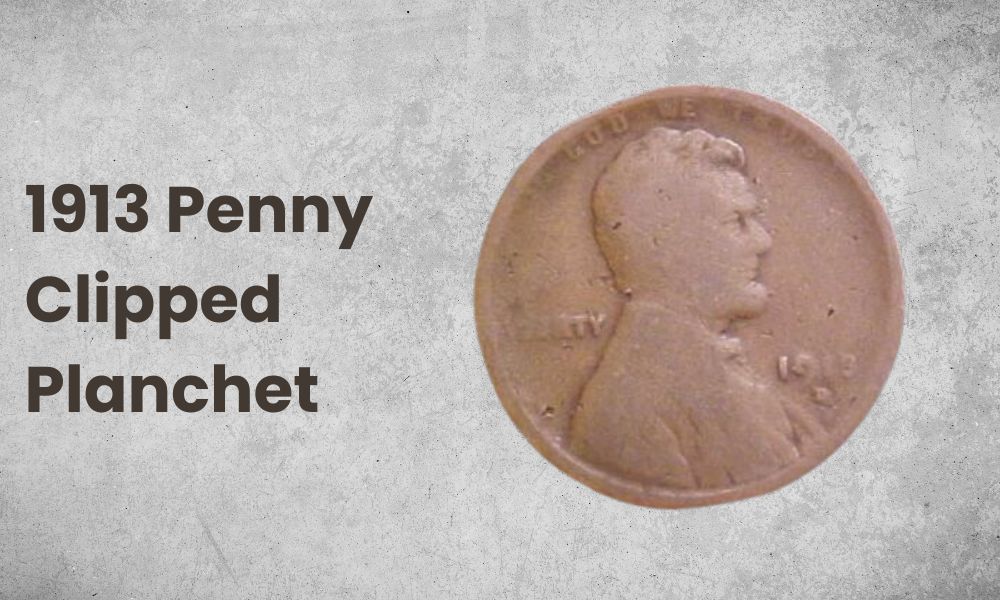
This is a very unique and interesting error. It gives a coin a one-of-a-kind appearance, so the collectors particularly appreciate it.
It happens when a part of a planchet gets accidentally clipped during the minting process.
It is easy to recognize as well – just look if a part of your coin is missing. If it does, you may have a highly valuable coin in your hands!
3. 1913 Penny Die Break
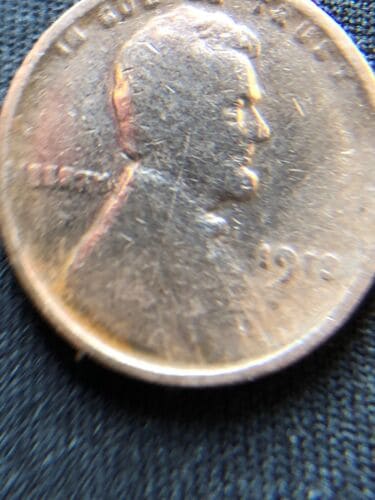
The dies that produce coins can get damaged over time. Due to the high number of strikes, parts of the dies can wear off or flatten.
This results in a coin with imperfections and irregularities. A part of the design may be missing or defective.
This error is difficult to differentiate from natural wear and tear, so if you suspect that your coin has a die break, you should consult a professional to check if it is just a result of years of circulation.
1913 Penny FAQ
Is a 1913 penny rare?
The US mint produced almost 100 million pennies in 1913, so they are not particularly rare. However, finding the ones in near-perfect or perfect condition can be very difficult, or at least quite expensive.
Where is the mint mark on a 1913 penny?
A 1913 penny produced in Philadelphia does not contain a mint mark. The coins produced in San Francisco have an S mint mark, while those produced in Denver contain a D mint mark. S and D mint marks can be found on the obverse side of a coin, right under the date.
How much is a 1913 coin worth?
A 1913 Lincoln wheat penny’s worth is dependent on the condition and rarity of the particular coin you have. The pennies in poor condition are worth only up to several dollars, but those in mint condition can reach the price of hundreds of dollars.
